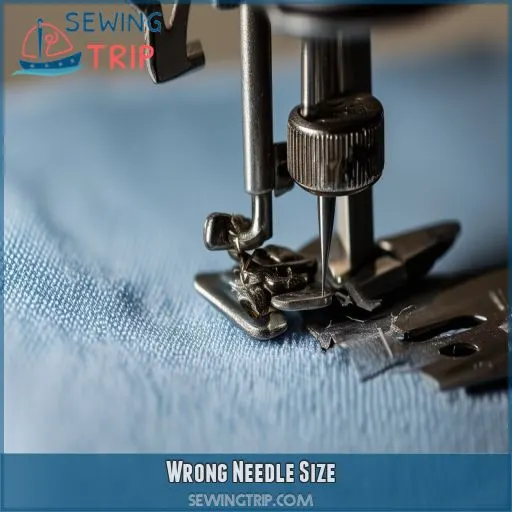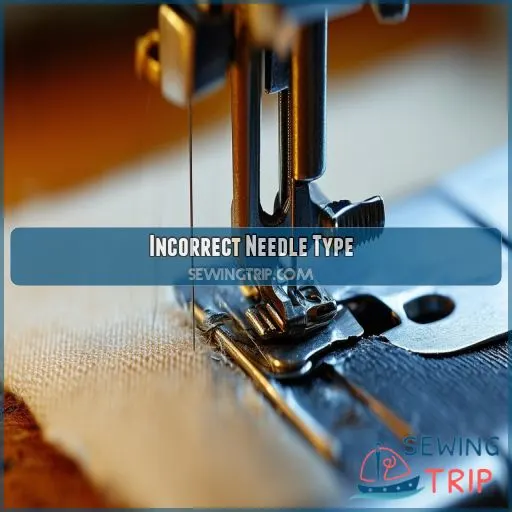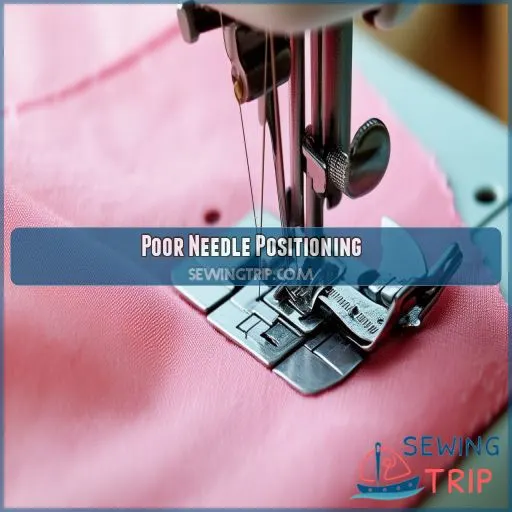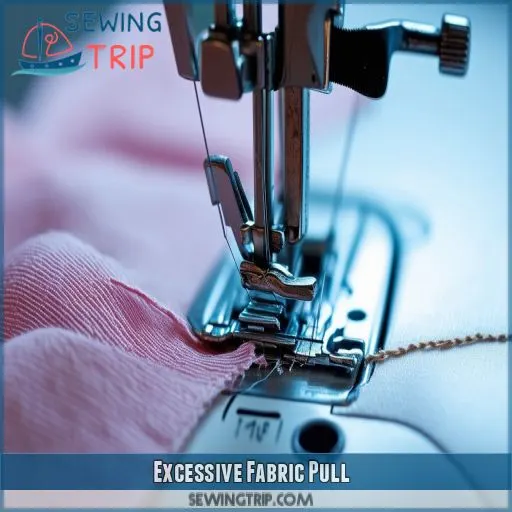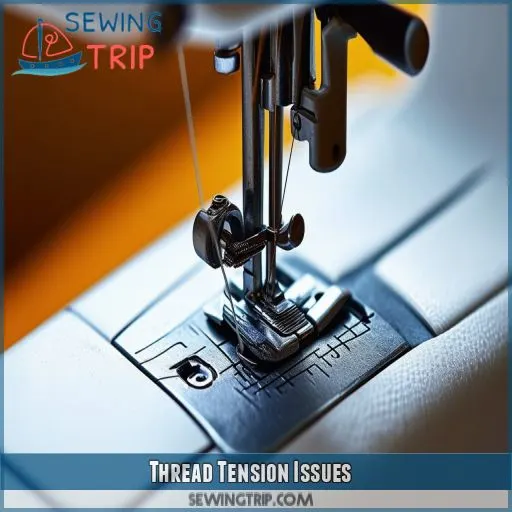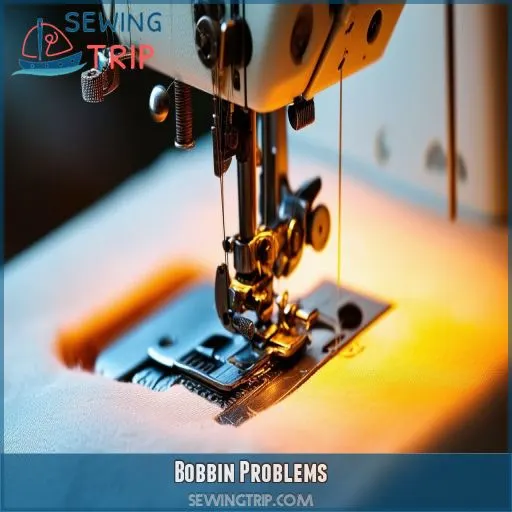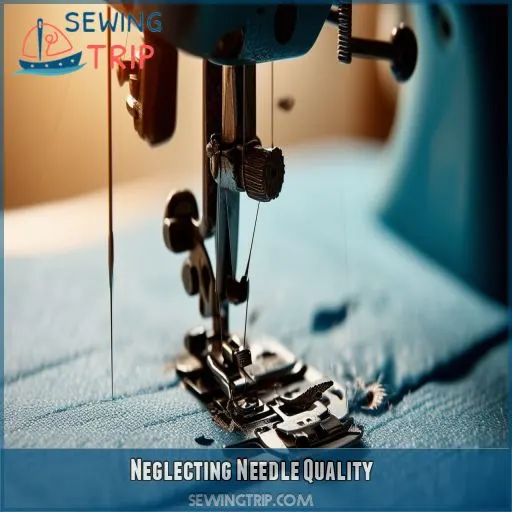This site is supported by our readers. We may earn a commission, at no cost to you, if you purchase through links.
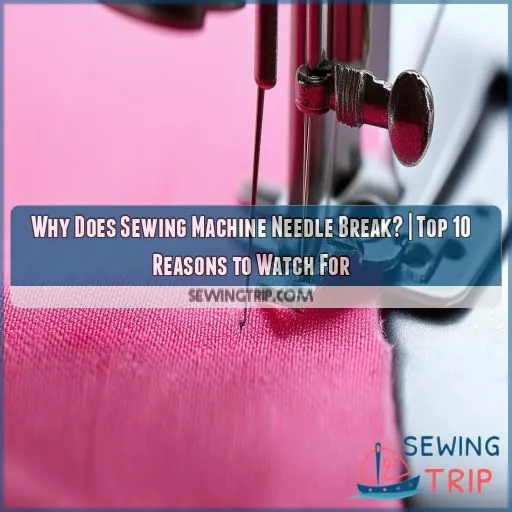
This article discusses the top 10 reasons for breakage, ranging from the wrong size of the needle down to the incompatibility of fabric with the entity being sewn. Looking at these factors, you will be able to take control over your sewing machine and prevent future damages to needles.
Read on to master the essentials and keep your sewing smooth.
Table Of Contents
- Key Takeaways
- Why Does Sewing Machine Needle Breaks?
- Wrong Needle Size
- Incorrect Needle Type
- Poor Needle Positioning
- Excessive Fabric Pull
- Loose Needle Clamp
- Thread Tension Issues
- Machine Maintenance Lapses
- Fabric Incompatibility
- Bobbin Problems
- Neglecting Needle Quality
- Frequently Asked Questions (FAQs)
- Conclusion
Key Takeaways
- If your needle keeps breaking, it’s like having a stubborn child who keeps getting into trouble. Check the basics first: are you using the right size and type of needle for the fabric you’re sewing?
- A Loose needle clamp is like a wobbly tooth – it’s going to cause problems sooner or later. Make sure your needle is nice and tight in its holder to avoid any nasty surprises.
- Thread tension is like a delicate dance – too tight and it’ll snap, too loose and it’ll cause a tangle. Find the perfect balance for your fabric and thread to keep your needle happy.
- Your sewing machine is like a car – it needs regular maintenance to keep it running smoothly. Clean it, oil it, and give it a little TLC to avoid any unnecessary needle breakage.
Why Does Sewing Machine Needle Breaks?
A sewing machine needle can break for several reasons. Using the wrong needle size or type, or poor needle positioning are common culprits.
Excessive fabric pull, a loose needle clamp, and Thread tension issues also contribute to the problem.
Don’t overlook maintaining your machine properly or ensuring fabric compatibility. Bobbin problems and neglecting needle quality can also lead to breaks.
Make sure your needle matches your fabric, your machine is well-oiled, and everything is aligned correctly. By addressing these factors, you’ll keep your machine running smoothly.
Stick around to discover more tips and tricks for smooth sewing!
Wrong Needle Size
If you’re experiencing needle breaks, the culprit could be as simple as using the wrong needle size. The thickness of your fabric plays a big role in determining the appropriate needle gauge and length.
Using a needle that’s too small for the job can cause it to bend or break under the strain. On the flip side, a needle that’s too large may create a hole in the fabric that’s larger than necessary.
Always consult your sewing machine’s manual or do a quick online search to find the recommended needle type and size for the project at hand. Swapping out a dull or damaged needle for a fresh, sharp one can make all the difference in preventing frustrating breaks.
Incorrect Needle Type
You’ve got the right size needle; are you sure it’s the correct type? The misuse of the wrong type of sewing needle makes any sewing project a nightmare. A wrong type affects both sharpness and strength.
Consider these common mistakes:
- Wrong Needle Point Shape: Ball point needles work quite well with stretchy fabrics while sharp points stay sharper longer on harsher ones.
- Wrong material for the needle: Ti needles may stand up to challenging materials much better than regular ones.
- Incorrect angle of point: Some embroideries need a certain angle of point with the needle while making stitches.
It can also put strain on the needle, which can bend or even break if chosen poorly. Always ensure your needle is suitable for the material and purpose of your work. This will save you the unnecessary wear and tear on both your needle and machine. Thus, select wisely to smooth out your sewing sessions.
Poor Needle Positioning
Moving on from the selection of the wrong type of needle, another critical factor to observe is incorrect positioning of the needle. If your Needle isn’t quite aligned correctly, you’re doomed. Bent needles, needle deflection, or even slight misalignments will have the needle hit the hook or bobbin case. At play here are timing issues whereby your hook timing’s out of balance. This occurs by sewing over pins, zippers, and using the wrong foot.
| Problem | Cause | Solution |
|---|---|---|
| Bent needle | Misalignment | Replace needle |
| Needle deflection | Cap driver height | Adjust driver height |
| Needle strikes | Timing issues | Synchronize timing |
Check the alignment and the position of the needle. The slightest mistake may incur a whole bunch of mishaps that involve breaking a needle or damaging the fabric. Perfecting technique will really help to feel much smoother stitches while sewing.
Excessive Fabric Pull
Pulling fabric through your sewing machine? It can cause needle breaking. Improper fabric feeding or pulling can make the needle bend or hit the throat plate. Here are some tips:
- Fabric Thickness: Thick fabrics need a sturdier needle. Consider needle size and type before beginning.
- Fabric Feeding: Let the machine feed the fabric. Pushing or pulling distorts the stitch and stresses the needle.
- Fabric Lubrication: Lubricate stiff or dense fabrics to ease needle penetration. Use products specifically for fabric.
- Correct Fabric Type: Match the needle to the fabric type. For example, use ballpoint needles for knits and sharp needles for wovens.
Always keep these tips in mind. Proper fabric handling reduces needle bending and breakage, ensuring smoother sewing projects.
Loose Needle Clamp
If your needle keeps breaking, the culprit could be a loose needle clamp. The needle holder, or clamp, should be tightened enough to hold the needle in position while sewing. If the needle clamp is loose, the needle moves around hitting the throat plate and/or the bobbin case causing breaks from the impact.
| Symptom | Cause |
|---|---|
| Failure to fully insert the needle | Loose needle clamp |
| Screw on needle not tight enough | Needle clamp loose |
The fix for this is simply tightening either the needle screw or clamp ripe enough to hold the needle firm. This is especially true for an embroidery machine, which operates very fast and could make a big mess with loose needles. Secure that needle before starting your project to prevent those frustrating breaks.
Thread Tension Issues
Thread tension problems can be a real pain in the neck if your sewing machine needle keeps on breaking. When the tension is too taut or too lax, the thread breaks or curls, putting unnecessary pressure on the needle.
- Tension Too Tight: If the thread tension is too high, it’ll yank on the needle excessively and break it. Check your settings.
- Tension Too Loose: Loose thread tension allows the thread to ‘wrap’ around the spool cap or thread guide; this will increase the potential for needle damage. Make sure the thread feeds smoothly.
- Thread Breakage: Improper tension frequently breaks the thread, thus putting pressure on the needle. Check for and fine tune regularly.
- Thread Tangling: Tangles are due to unbalanced tensions that allow the thread to move erratically, breaking a needle occasionally. Keeping tension at bay avoids these snags.
Machine Maintenance Lapses
If your sewing machine isn’t well taken care of, needles will break. Keeping your machine clean and lubricated and properly storing your needles make sure there aren’t any dust or lint accumulation that can cause the tension to be off balance. Insufficient oiling may also raise the possibility of friction between parts, which will also break the needle. If the screw that holds the needle is loose, then it vibrates back and forth, thus bending. Another very important thing is the synchronization of the hooks, due to misaligned hooks that hit into the bobbin case. Always make sure that the bobbin is inserted correctly.
| Maintenance Task | Consequence |
|---|---|
| Regular Cleaning | The accumulation of dust is prevented |
| Proper Lubrication | Reduces Friction |
| Proper Storage of Needles | Prevents Rusting, Bending |
| Hook Synchronization Check | Proper Needle Movement is Ensured |
Fabric Incompatibility
It can also be due to the incompatibility between the fabric you’re sewing and your sewing machine needle. Every type of fabric is available with different thicknesses, textures, and weaves. You have to use precise needle types to cope with these. An incorrect one is going to bend or deflect, bringing about breakage.
Here’s what to watch for:
- Thickness of fabric: Thicker materials require stronger needles; thin fabrics, finer one.
- Type of fabric: Stretchy fabrics require ballpoint needles to avoid skips and breaks.
- Fabric texture: Rough or coarse fabrics wear down the needle quickly.
- Stretch in fabric: High-stretch fabric may bounce off needles, leading to breakage.
- Weave of fabric: Tight weaves require sharper needles to penetrate effectively.
The right choice of the needle to be used on your fabric type and tension adjustment can prevent the breakage of needles. While using good quality needles, specifically made for the kind of fabric you’re dealing with, keep in mind that they’re very much necessary.
Bobbin Problems
Bobbin problems can also lead to needle breakage. If the bobbin isn’t aligned properly, it can cause the needle to strike the bobbin case, leading to bends and breaks.
Using the wrong bobbin size can also create issues, as the thread may not feed smoothly. Improper bobbin tension can result in thread catching on the spool or wrapping around the spool cap, which puts strain on the needle.
Make sure the bobbin thread is threaded correctly and the bobbin case is securely in place. Additionally, if the fabric is "helped" through the machine, it can disrupt the delicate bobbin balance, causing the needle to hit the bobbin case.
Neglecting Needle Quality
Neglecting needle quality can lead to frequent breaks and frustration. A bent or dull needle is prone to snapping, causing interruptions. Using a bad needle—poorly manufactured or mismatched for the project—can spell disaster for your sewing efforts. Improper needle tightening is another culprit; if the needle screw isn’t tight enough, expect issues. Quality needles like sharp point needles or titanium needles combat these problems.
Here’s what you should look out for:
- Bent Needle: Inspect for bends and replace immediately.
- Dull Needle: Swap out after significant use to maintain sharpness.
- Size Mismatch: Use the correct needle size for your fabric to avoid undue stress.
Ensure you’re using the best needle for the job to prolong its life and enhance your sewing experience.
Frequently Asked Questions (FAQs)
Why is my sewing machine needle breaking?
Your sewing machine needle may be breaking due to a variety of issues, like a bent or dull needle, incorrect needle size, loose needle, or even fabric that’s too thick. Check your machine and materials to identify the culprit.
What is the most common cause of needle breakage?
Surprisingly, the most common cause of needle breakage is improper insertion. When you don’t fully insert or tightly screw in the needle, it can strike the bobbin case or throat plate, leading to breaks.
What does it mean when a needle breaks?
When your sewing machine needle breaks, it typically means the needle has become too weak or damaged to withstand the forces of sewing. This can happen from overuse, striking hard objects, or using the wrong needle for the fabric.
How long does a needle last on a sewing machine?
A sewing machine’s needle normally is only good for 8 hours of sewing. To make sure everything works great, lots of stops and starts on your project are avoided, and your fabric doesn’t suffer from skipped stitches that destroy your work, change the needle.
How do fabric properties affect needle wear?
Fabric properties influence needle wear by affecting friction and resistance. Tough fabrics strain needles more, causing them to bend or dull quickly. Softening tough fabrics, using the correct needle type, and proper machine settings can mitigate this issue.
What are signs that a needle is too old?
You will know it’s time to get a new needle when it begins to bend, breaks easily, or makes uneven stitches. Replace it with a new one if it frequently snags on the fabric or creates excessive thread breakage—these assure peak performance.
How can heat treatment help when sewing tough fabrics?
When sewing tough fabrics, a little heat can work wonders. Softening the material with a quick steam or press helps the needle glide through effortlessly, reducing the risk of breakage. Try this trick for a smoother, sturdier sewing experience.
What role does hook timing play in avoiding needle breaks?
The hook timing synchronizes the rotary hook and the needle so that they move together. If it strays a bit, then the needle may strike and break itself. Proper hook timing is necessary to avoid breaking a needle and to make sewing smooth.
When should a titanium needle be used?
Ah, the titanium needle – a true workhorse for the sewing enthusiast! This hardy companion shines when tackling tough fabrics, ensuring your projects glide through with ease and minimal risk of breakage. Embrace its strength and let your creativity soar.
Conclusion
Knowing why the sewing machine needle breaks is really not that daunting of a process.
Knowing the top 10 reasons, which include using the wrong size and type of needles, poor positioning, and incompatibility with the fabric, empowers you with ways to reduce interruptions.
Be sure to inspect your needle clamp regularly, ensure correct thread tension, and inspect your bobbin.
Never forget to maintain your machine and only use good quality needles.
Get these things under your belt and you’ll ensure a much smoother and more enjoyable sewing time.

